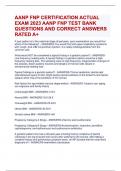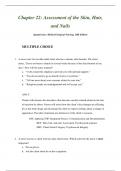Hoorcolleges Neuropsychologie | Anouk Wiersma
Neuropsychologie
Uitwerking hoorcolleges
Lecture 1: Introduction & the neuropsychologist
- The brain
o Grey matter: neurons
o White matter: myelin
o 4 lobes divided by sulci; frontal, parietal, occipital and temporal lobes.
o Limbic system: hypothalamus (homeostasis), thalamus (relays information), amygdala
(emotion), and hippocampus (memory conversion).
o Ventral and dorsal stream of vision.
Ventral: from occipital lobe to temporal lobe.
Dorsal: from occipital lobe to parietal lobe.
- Brain location and vocabulary
o
o
- Brain lesions
, Hoorcolleges Neuropsychologie | Anouk Wiersma
o Area of brain damage
o Can result from stroke, loss of blood flow, tumor, injury, etc.
- Principles of brain organization
o Clinical cases of brain lesions led to the discovery that certain types of damage were
consistent with certain types of symptoms.
Localization: damage was in a certain part of the brain concluded that
some brain functions were anatomically located.
Lateralization: damage was on a certain side of the head concluded that
some functions were usually on a specific side of the brain.
Distribution of function: lost functions are sometime rehabilitated
concluded that other parts of the brain can compensate.
Hierarchical organization: sophistication of functions very depending on
whether a ‘higher’ or ‘lower’ brain area was damaged brain processes
start with lower levels and are processed through increasingly higher levels.
Organization: hindbrain midbrain forebrain (from basic to more
sophisticated).
Processing begins with lower brain regions and then moves on to
higher regions.
Loss of function in higher brain regions (forebrain) = dissolution
(brain can compensate with lower regions, simplified behavior).
- History of neuropsychology
o Donald Hebb – father of neuropsychology
Hebbian theory: neural pathways develop based on experiences; as pathways
are used more, they become faster and stronger.
‘Use it or loose it’.
Hebbian assumptions of change: environment, culture, customs, family
history, lifestyle, and more shape who we are.
Fundamental properties of the brain: plasticity, flexibility, and
adaptability.
- Neurological examination
o Patient’s history
o State of awareness
Alert, drowsy, stupor, confused.
Speech abnormalities, facial asymmetries, body posture.
Emotions.
o Physical examination
Blood pressure, brain imaging, reflexes, pain, muscle movement, smell, etc.
o Disorders
Stroke, injuries and lesions may show asymmetry, loss of function.
Parkinson’s may show loss of smell and motor changes.
Dementia may show memory loss, disorientation, or agitation.
o Biopsychosocial model changes neuropsychology
Both biological, psychological and social circumstance influence mental
health.
Social support networks.
Patients’ sense of wellbeing.
Sometimes a mismatch between the patients’ needs and their social network
or environment can add stress that may impair healing.
, Hoorcolleges Neuropsychologie | Anouk Wiersma
- Genetics and the brain
o Stress and epigenetics
Stress have larger biological consequences than originally thought
Lamarckian theory, section 1.2.
Stress can influence epigenetic changes and mental health.
o Behavior is caused by genetics, epigenetics, and experience-based learning.
, Hoorcolleges Neuropsychologie | Anouk Wiersma
Lecture 2: The neuron
- Multiple Sclerosis (MS)
o MS is caused by damaged myelin.
o Cumulative damage produces brain lesion.
o MS is a heterogenous disorder = patients have different symptoms & experiences
depending on lesion size and locations, and how their individual brain is functionally
organized.
o MS affects brain and spinal cord.
o Common symptoms:
Muscle spasms, stiffness, weakness, or paralysis.
Mobility problems.
Numbness / tingling sensations, pain.
Speech and swallowing difficulties.
Vision problems.
Sexual problems.
Bladder or bowel problems.
Fatigue.
Difficulties thinking, learning, and/or planning.
Depression and anxiety.
o Types of MS
Primary progressive (PPMS): symptoms onset and
progressively get worse. No history of remission.
Relapsing remitting (RRMS):
Relapse = active symptoms / myelin
damage.
Remission = no current symptoms / myelin
damage.
Symptoms disappear and reappear across time.
Progressive relapsing (PRMS): similar to RRMS, but symptoms become
increasingly disabling with each relapse.
Very rare, very disabling.
Secondary progressive (SPMS): occurs after patient previous had SPMS,
remission stops, symptoms get steadily worse.
o Affected neurons
Immune cells attack the myelin sheath.
Exposed axon is scarred.
Information transmitted by that neuron is disrupted.
- The neuron – nerve cells
o Electrical and chemical signals pass from the axon terminal of one neuron to the
dendrites of the next neuron.
o Cell body / soma = grey matter.
o Myelin sheath = white matter.
o Many types of neurons
Unipolar neuron: not in the human body.
One extension form the cell body,
containing one axon with dendrites at its
tip.
Bipolar: rare in ear, nose and eye.
Neuropsychologie
Uitwerking hoorcolleges
Lecture 1: Introduction & the neuropsychologist
- The brain
o Grey matter: neurons
o White matter: myelin
o 4 lobes divided by sulci; frontal, parietal, occipital and temporal lobes.
o Limbic system: hypothalamus (homeostasis), thalamus (relays information), amygdala
(emotion), and hippocampus (memory conversion).
o Ventral and dorsal stream of vision.
Ventral: from occipital lobe to temporal lobe.
Dorsal: from occipital lobe to parietal lobe.
- Brain location and vocabulary
o
o
- Brain lesions
, Hoorcolleges Neuropsychologie | Anouk Wiersma
o Area of brain damage
o Can result from stroke, loss of blood flow, tumor, injury, etc.
- Principles of brain organization
o Clinical cases of brain lesions led to the discovery that certain types of damage were
consistent with certain types of symptoms.
Localization: damage was in a certain part of the brain concluded that
some brain functions were anatomically located.
Lateralization: damage was on a certain side of the head concluded that
some functions were usually on a specific side of the brain.
Distribution of function: lost functions are sometime rehabilitated
concluded that other parts of the brain can compensate.
Hierarchical organization: sophistication of functions very depending on
whether a ‘higher’ or ‘lower’ brain area was damaged brain processes
start with lower levels and are processed through increasingly higher levels.
Organization: hindbrain midbrain forebrain (from basic to more
sophisticated).
Processing begins with lower brain regions and then moves on to
higher regions.
Loss of function in higher brain regions (forebrain) = dissolution
(brain can compensate with lower regions, simplified behavior).
- History of neuropsychology
o Donald Hebb – father of neuropsychology
Hebbian theory: neural pathways develop based on experiences; as pathways
are used more, they become faster and stronger.
‘Use it or loose it’.
Hebbian assumptions of change: environment, culture, customs, family
history, lifestyle, and more shape who we are.
Fundamental properties of the brain: plasticity, flexibility, and
adaptability.
- Neurological examination
o Patient’s history
o State of awareness
Alert, drowsy, stupor, confused.
Speech abnormalities, facial asymmetries, body posture.
Emotions.
o Physical examination
Blood pressure, brain imaging, reflexes, pain, muscle movement, smell, etc.
o Disorders
Stroke, injuries and lesions may show asymmetry, loss of function.
Parkinson’s may show loss of smell and motor changes.
Dementia may show memory loss, disorientation, or agitation.
o Biopsychosocial model changes neuropsychology
Both biological, psychological and social circumstance influence mental
health.
Social support networks.
Patients’ sense of wellbeing.
Sometimes a mismatch between the patients’ needs and their social network
or environment can add stress that may impair healing.
, Hoorcolleges Neuropsychologie | Anouk Wiersma
- Genetics and the brain
o Stress and epigenetics
Stress have larger biological consequences than originally thought
Lamarckian theory, section 1.2.
Stress can influence epigenetic changes and mental health.
o Behavior is caused by genetics, epigenetics, and experience-based learning.
, Hoorcolleges Neuropsychologie | Anouk Wiersma
Lecture 2: The neuron
- Multiple Sclerosis (MS)
o MS is caused by damaged myelin.
o Cumulative damage produces brain lesion.
o MS is a heterogenous disorder = patients have different symptoms & experiences
depending on lesion size and locations, and how their individual brain is functionally
organized.
o MS affects brain and spinal cord.
o Common symptoms:
Muscle spasms, stiffness, weakness, or paralysis.
Mobility problems.
Numbness / tingling sensations, pain.
Speech and swallowing difficulties.
Vision problems.
Sexual problems.
Bladder or bowel problems.
Fatigue.
Difficulties thinking, learning, and/or planning.
Depression and anxiety.
o Types of MS
Primary progressive (PPMS): symptoms onset and
progressively get worse. No history of remission.
Relapsing remitting (RRMS):
Relapse = active symptoms / myelin
damage.
Remission = no current symptoms / myelin
damage.
Symptoms disappear and reappear across time.
Progressive relapsing (PRMS): similar to RRMS, but symptoms become
increasingly disabling with each relapse.
Very rare, very disabling.
Secondary progressive (SPMS): occurs after patient previous had SPMS,
remission stops, symptoms get steadily worse.
o Affected neurons
Immune cells attack the myelin sheath.
Exposed axon is scarred.
Information transmitted by that neuron is disrupted.
- The neuron – nerve cells
o Electrical and chemical signals pass from the axon terminal of one neuron to the
dendrites of the next neuron.
o Cell body / soma = grey matter.
o Myelin sheath = white matter.
o Many types of neurons
Unipolar neuron: not in the human body.
One extension form the cell body,
containing one axon with dendrites at its
tip.
Bipolar: rare in ear, nose and eye.






